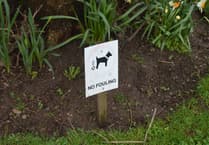In this week’s ManxSPCA column, general manager Juana Warburton speaks about the hazards facing hedgehogs and the five things people can do to help the species out...
We talk about hedgehogs regularly in these articles, but make no apology for issuing our annual hedgehog alert to coincide with national hedgehog awareness week which runs from 5th to 11th May.
As part of the awareness week, the British Hedgehog Preservation Society (BPS) is calling for us all to ‘welcome wildlife’ by creating a space for wildlife in our own gardens, and encouraging other people to do the same.
Last year’s focus was on two particular hedgehog hazards – the first being elastic bands; and the second netting – and it’s worth repeating.
The Royal Mail uses billions of elastic bands to help it sort the post it delivers, and sometimes these bands are dropped onto our pathways or gardens by mistake. The bands used are biodegradable but this degradation can take many years, and in the meantime the bands can harm wildlife. They can be mistaken for worms and ingested by birds, for example, or they can become entangled in the spines of hedgehogs and then become embedded into their skin.
So, if you see a discarded elastic band on the ground, always pick it up and dispose of it correctly.
The second issue, netting, covers a wide variety of nets – from those used to cover garden ponds, to those used by gardeners to protect their plants and trees. Sports netting is also very common – from the nets behind goal posts to the nets surrounding cricket pitches.
The BPS asks that gardeners tie their netting securely, and keep it at least 30cm from the ground so that hogs can pass freely under it. The netting on garden ponds also needs to be properly secured, ideally with heavy stones to prevent a hog going underneath. Any excess netting should either be cut off or wrapped up very tightly and tied with rope.
When a hedgehog gets trapped in netting it tries to free itself but usually ends up becoming even more entangled, like Netty in the pictures. Even if you are able to cut the hog free, it is likely that the netting has broken the skin in some places and these wounds may become infected. It’s usually best to pop the hog into a ventilated box with some food (meaty dog or cat food is best) and a bowl of shallow water, with a fleecy blanket or towel to hide under, and then to bring it to us, or your nearest vet, for a check-up.
Regular readers will not need reminding that the hedgehog is a declining species, due in the main to the use of pesticides and a loss of habitat, as well as the large numbers that are killed on our roads.
The People’s Trust for Endangered Species (PTES) estimates that hedgehog populations fell by as much as 50 percent in the UK between 2000 and 2019, which is a frightening statistic.
Besides picking up elastic bands and taking care with netting, here are some reminders about other ways you can help hedgehogs at this time of year:
- Create a hedgehog feeding station using both wet and dry dog and cat food (but not the fish variety), white meat, nuts, raisins and chopped up eggs. Hedgehogs also need a fresh supply of water in a shallow bowl.
- Cut a hole, or holes, in your garden fence to allow hedgehogs to roam more freely to search for food.
- Don’t use slug pellets and, instead, go for safer alternatives such as sprinkling crushed eggshells or coffee grounds around any vulnerable plants.
- Ensure unnetted garden ponds have a hedgehog-friendly ramp in them, such as a piece of timber, so that a thirsty hedgehog doesn’t accidentally drown.
- Take great care when using strimmers and check long grass and hedges thoroughly for any hedgehogs (and frogs, for that matter) that may be hiding in them.




